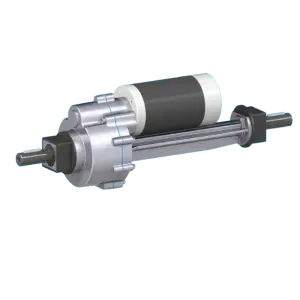Introduction
In the rapidly evolving world of electric vehicles, the electric transaxle has become a crucial component. As a highly integrated system combining an electric motor, transmission, and differential into a single unit, its performance and longevity are vital for vehicle operation. For international wholesale buyers, understanding the key components of an electric transaxle that require regular attention can help ensure the quality and reliability of the products they purchase. This blog will explore these components in depth.

The Electric Motor
The electric motor is the heart of the electric transaxle, converting electrical energy into mechanical energy to drive the vehicle. Here are some aspects that need regular attention:
Performance and Efficiency:Regularly monitor the motor’s power output, torque, and efficiency. Sudden drops in performance may indicate issues such as winding damage or bearing wear. Typically, the efficiency of high-efficiency motors is generally over 90%.
Temperature:Excessively high temperatures can affect the motor’s performance and lifespan. Ensure proper cooling systems, such as cooling plates or heat sinks, are functioning effectively. The normal operating temperature range for most electric motors is between 60℃ and 80℃.
Insulation Condition:Over time, the insulation of the motor windings may age and degrade. Regularly inspect the insulation resistance to prevent short circuits and other electrical issues.
The Transmission
The transmission adjusts the output speed and torque of the motor to achieve higher efficiency. The following parts require attention:
Gear Wear and Lubrication:Gears are key components for power transmission. Check for wear, pitting, or cracks on the gear teeth. Ensure adequate lubrication with the correct type and amount of lubricant to reduce friction and wear. Gearbox transmission efficiency can reach up to 95%, and proper lubrication helps maintain this efficiency.
Transmission Ratio and Smoothness:Verify that the transmission ratio meets the design requirements and that shifting between gears is smooth and accurate. Noise or vibration during gear shifting may indicate issues such as improper gear meshing or bearing damage.
The Differential
The differential allows the wheels to rotate at different speeds when turning, which is essential for vehicle stability and handling. Regular maintenance of the differential is necessary:
Gear Inspection and Lubrication:Like the transmission gears, the differential gears should be inspected for wear and damage. Replace worn gears promptly and ensure proper lubrication to maintain their performance and lifespan. Differential efficiency generally ranges from 95% to 98%.
Sealing and Leakage Prevention:Check the seals and gaskets of the differential to prevent lubricant leakage and the ingress of contaminants. Leakage can lead to insufficient lubrication of the gears and accelerated wear.
The Control Module
The control module is the “brain” of the electric transaxle, responsible for controlling the operation of the entire system. Regular attention should be given to:
Software Updates and Upgrades:Timely updates to the control module’s software can enhance system performance, add new functionalities, and fix potential issues. Check the manufacturer’s website regularly for updates and follow the proper procedures for installation.
Connections and Signal Transmission:Inspect the electrical connections of the control module to ensure they are tight and secure, with no looseness, corrosion, or interference. Reliable connections are crucial for accurate signal transmission and system operation.
Bearings
Bearings are present in various parts of the electric transaxle, such as the motor shaft and transmission shaft, supporting the rotation of components and reducing friction. Regular checks are needed:
Wear and Damage:Inspect bearings for wear, noise, or vibration. Worn or damaged bearings can affect the alignment and balance of rotating components, leading to decreased performance and potential failure.
Lubrication and Sealing:Ensure bearings are properly lubricated and that seals are intact to prevent lubricant leakage and contamination by dust or moisture.
Seals and Gaskets
Intact seals and gaskets are essential for preventing the ingress of contaminants such as dust, dirt, and water into the electric transaxle. Regularly inspect seals and gaskets for wear, cracks, or deterioration, and replace damaged ones promptly to maintain a clean internal environment.
Cooling System
The cooling system helps dissipate heat generated during operation, ensuring the electric transaxle works within an appropriate temperature range. For liquid-cooled systems, regularly check the coolant level, quality, and cooling plate condition. For air-cooled systems, ensure the heat sink is clean and the cooling fan operates normally.
Sensors and Monitoring Devices
Various sensors and monitoring devices, such as speed sensors, torque sensors, and temperature sensors, provide real-time data on the electric transaxle’s operating status. Regularly calibrate and inspect these sensors to ensure accurate and reliable data, enabling timely detection of potential issues.
Conclusion
The electric transaxle is a complex and sophisticated component, and regular attention to its key components is essential for maintaining its performance and extending its lifespan. For international wholesale buyers, understanding these maintenance needs can help them better assess suppliers’ technical capabilities and product quality, make informed purchasing decisions, and provide valuable guidance to customers on proper usage and maintenance. By working with suppliers who prioritize quality and maintenance, buyers can ensure the reliability and durability of electric transaxles, meeting the growing demand for electric vehicles in the market.
Post time: May-28-2025

